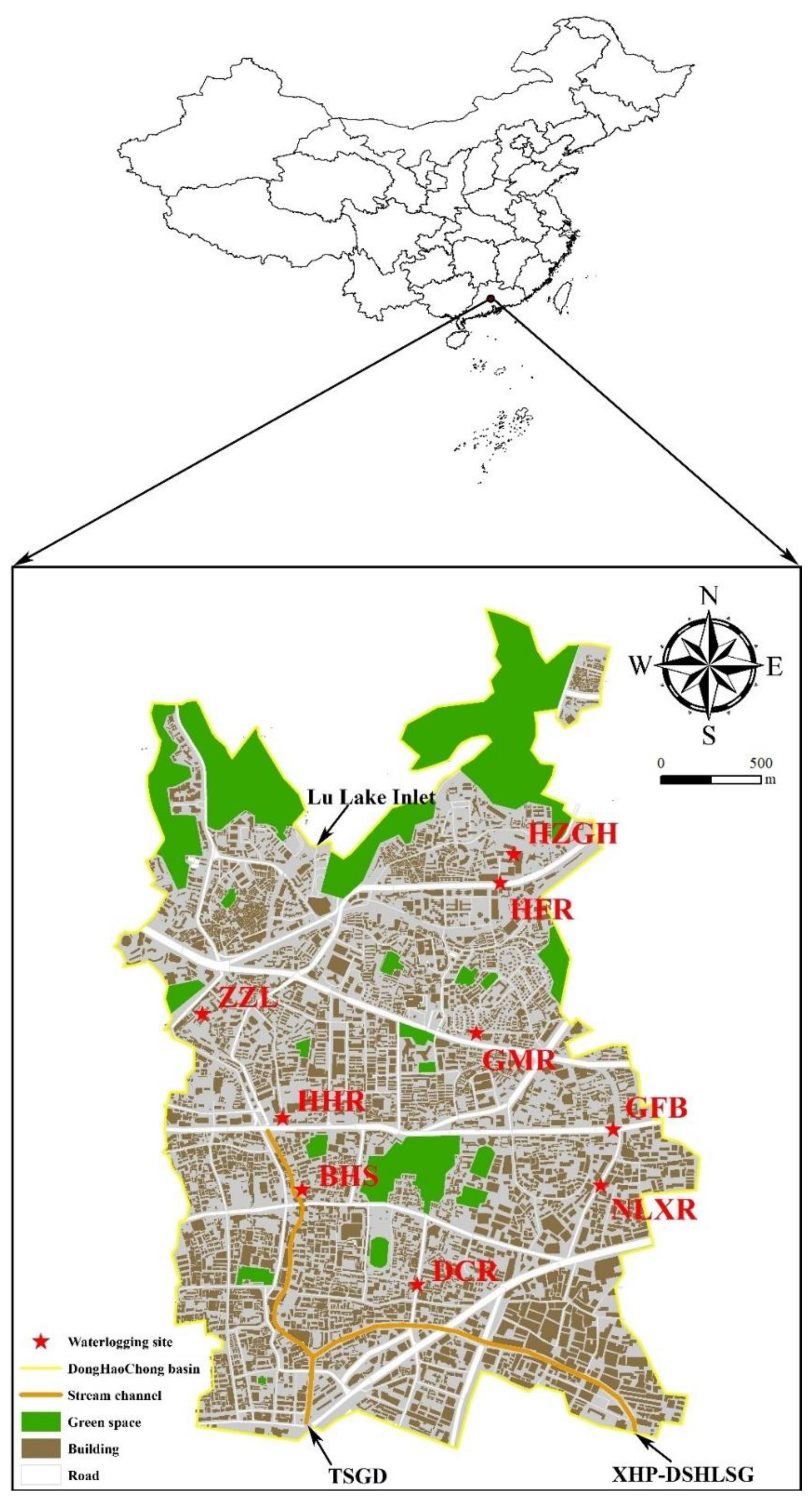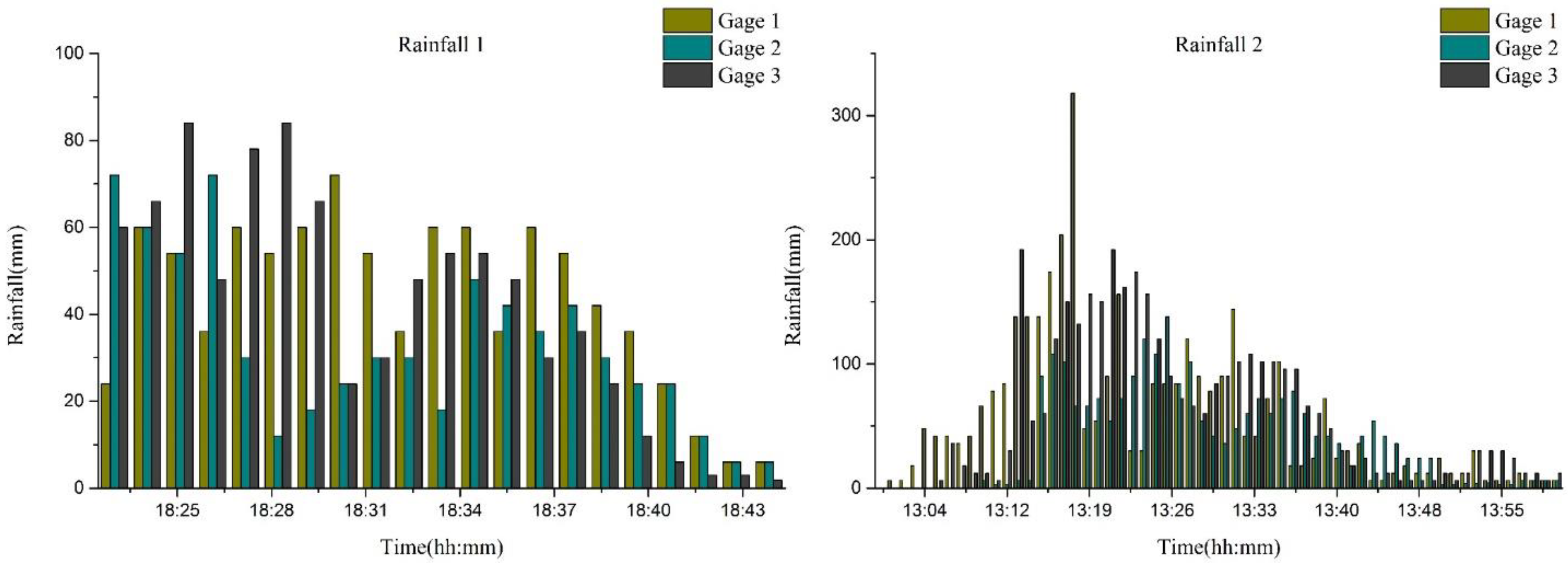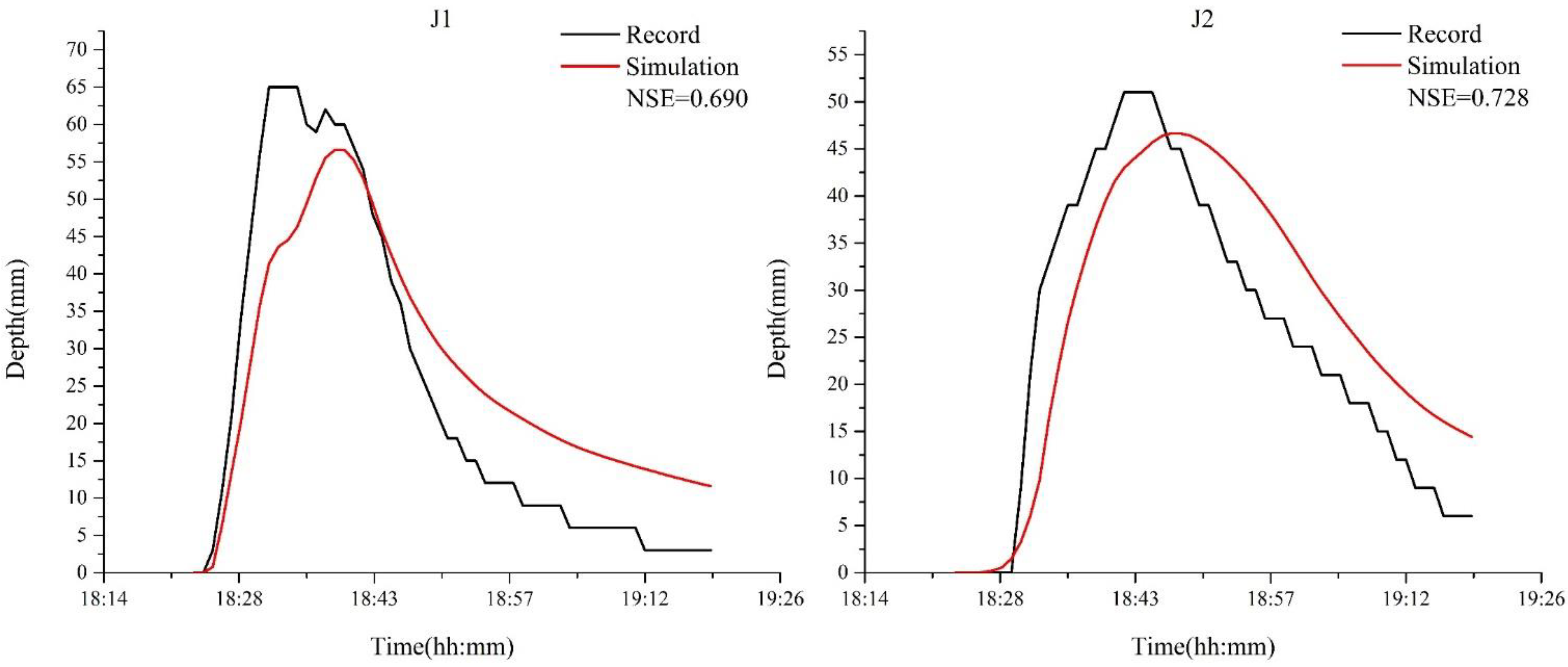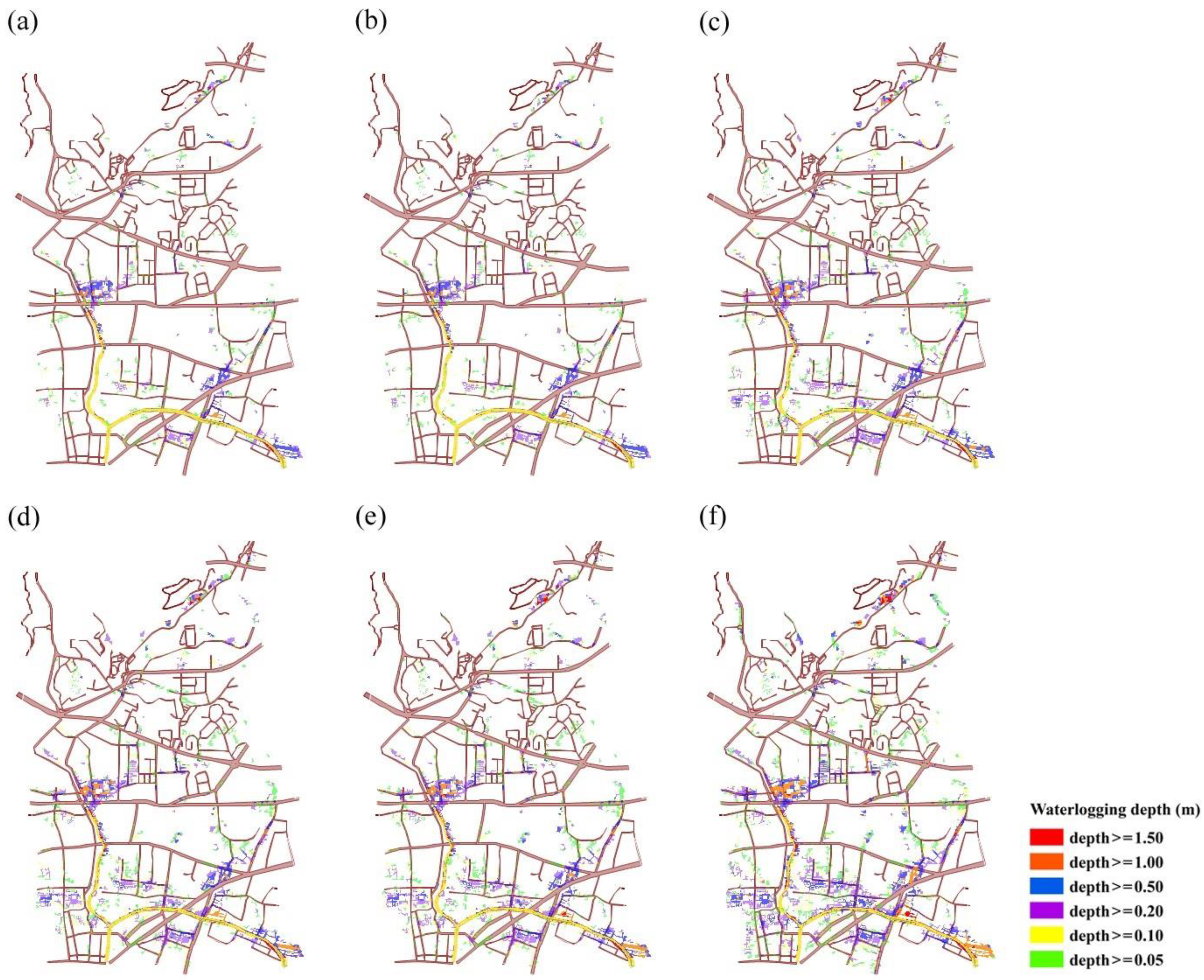1. Introduction
The atmospheric concentrations of greenhouse gases have been increasing since industrialization due to human activity, and have led to significant climate change that intensifies the global hydrological cycle and influences climatology characteristics. Rainfall will become more uneven and intense [
1], and such variations in rainfall have had serious impacts on urban flooding in recent years [
2].
General circulation models (GCMs) are a class of computer-driven models for understanding the historical climate and projecting future climate change, and are considered to be the most reliable resources that are currently available for investigating and predicting climate change [
3,
4,
5]. However, the resolution of GCM outputs tends to be coarse and cannot be used directly in hydrological modeling for regional climate impact studies. A regional climate model (RCM) can ameliorate this deficiency and its high resolution can capture smaller-scale topography and land surface characteristics better, providing more detailed information regarding local climate change as compared to GCMs [
6,
7]. Consequently, RCMs have been used extensively to assess regional climate change and extremes. Gao et al. [
8] projected changes in extreme precipitation using the RegCM3 over the Mediterranean region, and their results suggested that the distribution of precipitation shifted and broadened, with an increased probability of events that might result in flooding. Ji et al. [
9] conducted a RegCM4 downscaling projection over China, as RegCM can provide more reliable future climate change predictions at regional to local scales. Climate change has affected urban floods in recent years, and has also increased the uncertainties in flood management [
10].
Several catastrophic rainstorm events have occurred in the past few years [
11,
12]. Consequently, inundation control and urban drainage systems will encounter substantial challenges [
13,
14]. Many cities have recently faced extreme rainfall events, which have resulted in enormous economic losses, injuries, and mortalities [
15]. For instance, in England, the rain depth for the period of May to July 2007 was 406 mm, but a new 24 h rainfall record (316 mm) was observed at Seathwaite, Borrowdale, in 2009 [
16]. An extreme rainfall event hit Beijing on 22 July 2012, with a record rainfall amount of 460 mm, which inundated many roads with trapped cars and buses, as well as collapsed buildings, in waist-deep water [
17]. Many researchers state that the pressure on the urban drainage system is expected to increase [
18,
19]. Improved inundation risk management in response to the increased inundation risk is important [
20].
Urban drainage systems are important infrastructural components in urban areas due to the high potential of flooding in these regions [
21,
22]. The operation of drainage systems is an issue of great importance as they affect daily urban activities [
23]. The design and operation of an urban drainage system are closely associated with the rainfall characteristics of the local urban area, especially the intensity and amount of rainfall. The increasing global mean temperature has been of concern for several years as increasing temperatures intensify the hydrological cycle accordingly, and a larger number of heavy precipitation events will likely occur in the 21st century, according to the Intergovernmental Panel on Climate Change [
24]. When assessing the impact of climate change, especially precipitation changes, on a city through the urban drainage system, some problems need to be considered. Two of the main problems are: (1) the type of input rainfall data used for model simulations to represent future change, and (2) how the urban drainage impacts should be measured to reflect and accurately describe the event and system characteristics [
25]. A direct approach for using climate model information and change factors is the ′′delta change method′′ [
26,
27]. Semadeni-Davies et al. [
19] used the delta change approach for urban hydrology, and compared present and future climate simulations from a regional climate model to determine monthly changes that were then applied to observed rainfall data in two groups (drizzle and storm). Olsson et al. [
28] further developed this approach with more focus on rainfall intensity, and used a regional climate model to compare a control period (present time) and future periods. These generated factors considered rainfall with different intensities and differences according to the time of year (summer, autumn, winter, and spring).
Previous studies usually relied on observed rainfall, with less consideration of design rainfall. In this study, an algorithm based on the delta change and annual maximum value methods was developed to derive future short-duration design rainfall. This algorithm evaluates the effects of climate change on the urban flood regime and characteristics. To achieve these objectives, the following three steps are followed: (1) the rainstorm intensity formula is derived considering climate change in this study. (2) The impact of climate change on urban inundation is considered. (3) The impact of climate change on urban waterlogging is considered. This paper is organized as follows: the study area is introduced in the following section; subsequently, the model and methodologies are presented. This is followed by a section which presents the results and discussions; finally the main findings are summarized in the conclusion. The findings can be further utilized in the development of appropriate urban runoff management schemes and drainage system designs for the local climate.
4. Results
4.1. Future Climate Change
The performance of RCM downscaling outputs is evaluated by comparing with the observations of 15 meteorological stations, on the basis of the mean error (ME), root mean squared error (RMSE), temporal correlation coefficient (TCC) and spatial correlation coefficient (SCC). The RCM can reasonably capture the intra-annual variability of precipitation (figure not displayed), although there are still some biases between the simulations and observations. The annual ME, RMSE, TCC, and SCC is −29.03%, 33.73 mm, 0.95, and 0.53, respectively.
The simulations of CDD, Rx1day, R25mm, and Rx5day is compared with the observations (figure not displayed). For CDD, the simulations results have a well performance with the observations, with an average overestimation of 2.77%. The Rx1day, Rx5day and R25mm tend to be underestimated by 33%, 24%, and 12.74 days, respectively, which indicates an uncertainty involved in RCM for reproducing extreme precipitation events. However, overall, the RCM can reproduce precipitation extremes and is therefore judged to be applicable for the study area.
4.2. Future Design Short Duration Rainstorm Pattern
Table 1,
Table 2 and
Table 3 represent the Pearson-3 curve fitting, and
Table 4,
Table 5 and
Table 6 show the relationship between the intensity, duration, and frequency of rainstorms under the control period, RCP4.5, and RCP8.5, respectively.
Table 7 shows the parameters of the urban design rainstorm intensity. The results indicate that the rRMSE of the reference period, RCP4.5, and RCP8.5 did not exceed 5%, and the RMSE values are 0.06, 0.065, and 0.069 mm/min, respectively [
33]. Finally, the design rainstorm formula under climate change can be represented as follows:
Based on the Chicago hyetograph method,
Figure 2 shows the impact of climate change on the design rainstorm. The peak values increased by 0.073, 0.013, 0.205, 0.262, 0.319 mm/min from those of the reference period (RF) under scenario RCP4.5 in different return periods. The rainfall amount increased from 4.37% to 9.19% under scenario RCP4.5. The peak values under RCP8.5 significantly increased, with a maximum increase of 1.591 mm/min under the 20a return period. The amount of rainfall increased by 28.79%, 30.20%, 31.61%, 32.45%, and 33.15% in the 1a, 2a, 5a, 10a, 20a return periods, respectively. The increasing intensity of the future short-duration design rainstorm will directly impact the urban drainage system and cause more severe waterlogging issues.
4.3. Urban Flood Model Calibration and Validation
Two historical rainfalls (1 and 2) were selected as the model inputs for calibration and validation (
Figure 3). The first rainfall began at 6:24 pm on 15 July 2017, and ended at 6:44 pm. The maximum intensity recorded by three rain gages was 84 mm/h, which occurred at 6:26 for Gage 1. The duration of Rainfall 1 was short, and the intensity was even lower than that of the design rainstorm with a 1a return period. The second rainfall began at 1:00 pm on 5 September 2017, and lasted for approximately 1 h. The intensity of Rainfall 2, with a peak of 5.3 mm/min, was much larger than that of Rainfall 1. Rainfall 1 caused few inundations in the research region, while Rainfall 2 caused large areas of inundations. Therefore, the junction water depth is applied to calibrate Rainfall 1, and the inundation depth is taken as the model calibration criteria for Rainfall 2.
Two junctions (J1 and J2) located on the main pipelines were selected as the research objects in the calibration for Rainfall 1. The model parameters were adjusted according to the Nash–Sutcliffe efficiency coefficient (
NSE) calibration method (Equation (7)), and the results are shown in
Figure 4. Generally, the precision of the models is high when the
NSE value exceeds 0.6. The
NSE values of J1 and J2 are 0.690 and 0.728, respectively.
where
is the observed value at time
,
is the modeled value at time
, and
is the average value of the observed data throughout the total modeling time
.
Rainfall 2 caused severe inundations in the research region, and the inundation extents and depths are used in validation.
Table 8 shows a detailed comparison of the results of the maximum inundation depths with the data recorded on-site. HHR exhibits the largest error of 0.414 m, while the errors at the other sites are acceptable and do not exceed 0.2 m. In summary, this urban flood model can reproduce the historical rainfall-induced inundation after calibration and validation.
4.4. Climate Change Impact on Inundation
The changes in the inundation nodes under the two emission scenarios exhibited very similar patterns.
Figure 5a–c show the distribution of inundation nodes in the 2a return period during the reference period, RCP4.5, and RCP8.5, respectively.
Table 9 shows the variation in the number of inundation nodes under RCP4.5 and compares it with that of the reference period. The maximum inundation volume and inundation node are both increasing. In the 20a return period, the maximum inundation volume increased by approximately 106.2 m³, and the proportion of the inundation node increased by 2.217%.
Table 10 shows the variation in the number of inundation nodes under RCP8.5 and compares it with that of the reference period. The inundation volume and nodes significantly increased under the RCP8.5 scenario. The maximum inundation volume increased by approximately 636.7, 708.9, 742.8, 786.4, and 828.7 m
3 for each return period, respectively, and the number of inundation nodes increased by 342, 330, 386, 415, and 416 for each return period.
Figure 5d–f show that the maximum inundation volume of over 100 m
3 spread to the whole basin in the 20a return period under scenario RCP8.5.
Table 11 shows the conduit surcharge conditions under RCP4.5 and compares them with those under the RF period. In the 1a return period, the conduit surcharge below 0.5 decreased by approximately 0.89%. The surcharge conduit proportion decreased by 0.82% and 0.6% under surcharge conditions ranging from 0.5 to 0.8 and 0.8 to 1, respectively. The proportion of full load operation increased by 2.07%, in which the proportion of conduits with full loads increased by approximately 1.75% due to the insufficient downstream flow capacity and 0.32% due to its own insufficient flow capacity. In the 20a return period, the conduit surcharge below 0.5 decreased by approximately 0.89%. The surcharge conduit proportion decreased by 0.82% and 0.6% under surcharge conditions ranging from 0.5 to 0.8 and 0.8 to 1, respectively. The proportion of full load operation increased by 1.59%, in which the proportion of conduits with full loads increased by approximately 0.92% due to the insufficient downstream flow capacity and 0.67% due to its own insufficient flow capacity.
Table 12 shows the conduit surcharge conditions under RCP8.5 and compares them with those under the RF period. In the 1a return period of RCP8.5, conduit surcharges below 0.5 decreased by approximately 6.26%. The surcharge conduit proportion decreased by 4.45% and 0.94% under surcharge conditions ranging from 0.5 to 0.8 and 0.8 to 1, respectively. The proportion of full load operation increased by 11.65%, in which the proportion of conduits with full loads increased by approximately 8.52% due to the insufficient downstream flow capacity and 3.13% due to their own insufficient flow capacity. In the 20a return period, the conduit surcharge below 0.5 decreased by approximately 2.97%. The surcharge conduit proportion reduced by 4.51% and 0.81% under surcharge conditions ranging from 0.5 to 0.8 and 0.8 to 1, respectively. The proportion of full load operation increased by 8.29%, in which the proportion of conduits with full loads increased by approximately 6.12% due to the insufficient downstream flow capacity and 2.17% due to its own insufficient flow capacity.
Figure 6 presents the spatial distribution of conduit surcharge conditions and compares them with the RF period; the most conduit surcharges exceed 1, which is transferred from the surcharge values of 0.8–1 and 0.5–0.8 under scenarios RCP4.5 and RCP8.5, respectively.
4.5. Climate Change Impact on Urban Waterlogging
The waterlogging distribution is shown in
Figure 7, and the effect of climate change on waterlogging is investigated in this study. For further analysis, the RCP scenarios in nine typical sites of the DHC Basin are compared with the reference period.
Table 13 shows the changes in the runoff depth under RCP4.5 and compares them with the reference period. The runoff depth increased by 0.007–0.083, 0.005–0.055, 0.001–0.054, 0.003–0.037, and 0.003–0.051 m in the five return periods, respectively. The BHR site is expected to experience the largest runoff depth, with an increase of 0.083 m in the 1a return period. Under the RCP8.5 scenario, the runoff depth significantly increased at most sites.
Table 14 shows the changes in runoff depth under the RCP8.5 scenario relative to those of the reference period. The maximum runoff depth increased by 0.369, 0.314, 0.290, 0.307, and 0.314 m in five return periods, respectively. The maximum change in the runoff depth can be observed at NLR in the 1a return period, while the smallest increase can be observed at GMR, with an increase of 0.020 m in the 5a return period.
Table 15 shows the variation in the submerged area. Under scenario RCP4.5, the changes in the submerged area increased by 5.53%, 5.21%, 5.09%, 10.49%, 4.67% in the five return periods. The largest change in the submerged area can be observed in the 10a return period, with an increase of 179,500 m
2. Under scenario RCP8.5, the submerged area is remarkably dispersed in the study area. The changes in the submerged area increased by 47.06%, 41.84%, 40.51%, 43.07%, and 31.50% in the five return periods. The maximum change in the submerged area can be observed in the 10a return period with an increase of 736,700 m
2.
5. Discussion
This study was conducted to explore the effect of climate change on urban drainage systems, based on two RCP scenarios. Overall, urban inundation and waterlogging will become more intense in the future, which is somewhat consistent with previous findings for urban areas [
25,
27,
47]. We also found that the increase in the intensity of inundation and waterlogging is expected to be more pronounced under the high-emissions scenario (RCP8.5) than those under the moderate-emissions scenario (RCP4.5). Therefore, this study illustrates that the current urban drainage system will cause more austere urban waterlogging. The design of urban drainage systems needs to consider more complex environmental and adverse conditions.
Generally, GCM and emission scenarios are considered to be the greatest sources of uncertainty in relation to climate change, especially for extreme climate events [
48,
49]. The validation of the climate model simulation suggested that the RegCM4.6 can reasonably reproduce the variability of monthly precipitation and extreme precipitation events compared with the observations. However, it should be emphasized that some discrepancies were still detected between the simulations and observations, suggesting that there is an uncertainty in the projection of future flooding risk. Generally, GCM and emission scenarios are considered to be the largest sources of uncertainty in relation to climate change, especially for extreme climate events. We used only RCM driven by one GCM, which may limit the scope of this study and there exist further uncertainties associated with projections of future precipitation and climate extremes. Further studies are required to be focused on different GCMs and emissions scenarios toward a more reliable projection of climate change. Further studies are required to investigate these, using different methods for downscaling the projections (such as dynamic and statistical downscaling) and different GCMs and emission scenarios to drive the simulations. Therefore, effectively using multiple models when applying downscaling techniques with more confidence should be considered in future research. By comparing the results of different simulations, we can improve our understanding of some of the uncertainties associated with climate change, and a consistent timescale will be applied to further detect the impact of climate change on urban drainage systems.
Integrating the delta change and annual maximum value methods to derive a design rainstorm is a new research area for understanding the impact of climate change on the urban drainage system. Unlike previous studies, which mainly focus on hourly rainfall derived by a climate model that is associated with great uncertainty [
25], this method mainly focused on short-duration design rainfall, which could aid the design of future sophisticated urban drainage systems. However, it should be emphasized that, based on the theory of the delta method, the selection of a timescale between delta change and annual maximum value methods is neglected when developing the design formula. This could result in some discrepancies in the derivation of design rainfall. In future investigations, the annual maximum rainstorm factor for each timescale should be consistent with that of the delta factor. The different applicable distribution analysis is partly overlooked in this study. Next step, the different distribution should be incorporated in the curve fitting to explore the effects of applicable distribution. By comparing the results of different simulations and curve fitting, the derivation of a design rainstorm will be more reasonable.
6. Conclusions
In this study, the reference urban drainage system of and future inundation and waterlogging in the DHC Basin were investigated using the output of the delta change method by GFDL-ESM-2M. The future design rainfall is derived and then integrated with InfoWorks ICM to evaluate the urban inundation and waterlogging risk. The main findings can be summarized as follows:
The delta change and annual maximum value methods were integrated to determine the future urban design rainfall under RCP4.5 and RCP8.5 scenarios. Pearson-3 type curve and parameter optimization were applied to determine the future design rainfall formula. This method offers a new insight to aid in managing the effect of climate change on urban areas. Compared to the reference period with the Chicago hyetograph method, the peak value and amount of rainfall increased under the RCP4.5 and RCP8.5 scenarios, indicating that the urban drainage system will face more austere urban flood control pressure.
The InfoWorks ICM model was used to evaluate the variations in urban inundation. Compared to the reference period, the number of inundation nodes and inundation volume were increasing in all five return periods in the DHC Basin under scenarios RCP4.5 and RCP8.5. Their increase was more significant under RCP8.5 than that under RCP4.5. The variation in inundation was most severe under the 20a return period. The conduit surcharge conditions showed that the proportion of fully loaded conduits increased in all return periods. The largest percentage increase in the proportion of fully loaded conduits could be observed in the 1a return period. Transformation of the conduit network should be considered under multiple return periods.
The 2-D model was implemented to evaluate the changes in waterlogging. Nine typical waterlogging sites in the DHC Basin were selected to measure the variations in runoff depth. Compared to the reference period, the runoff depth increased in nine sites during all return periods. The increases under RCP8.5 were more significant than those under RCP4.5 scenarios. Throughout the basin, the increase in the submerged area did not exceed 15% under RCP4.5, but it exceeded 30% under scenario RCP8.5.













